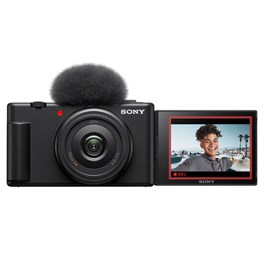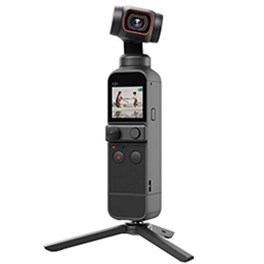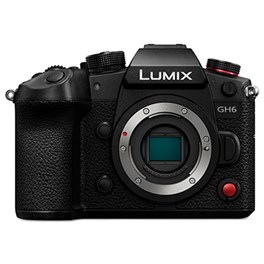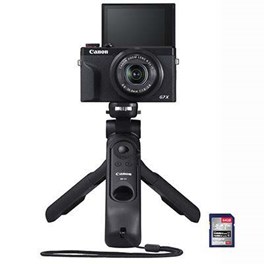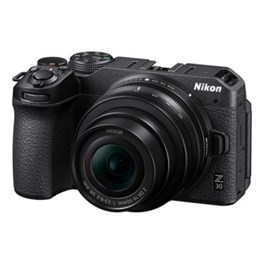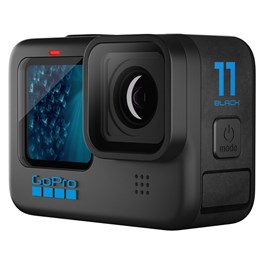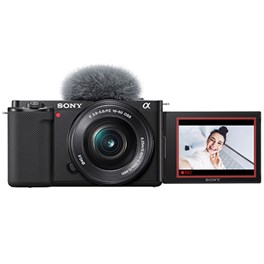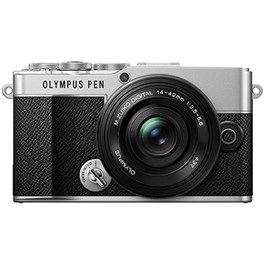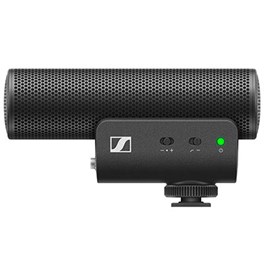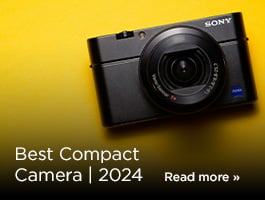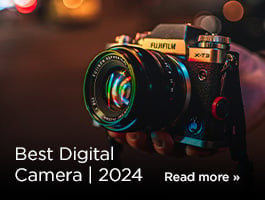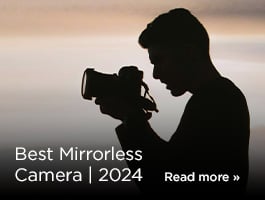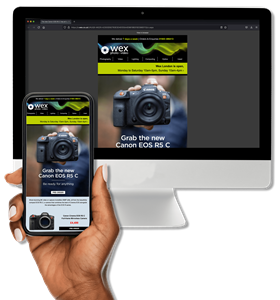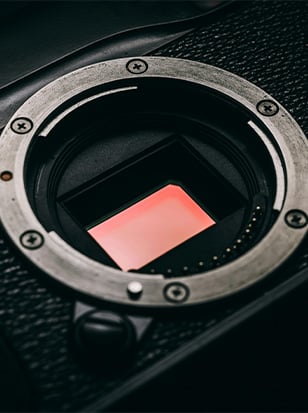
So, let’s get the obvious out of the way – for the majority of users, the best camera for TikTok is a phone. It’ll automatically shoot in the right aspect ratio to be viewed on TikTok, it’ll allow you to shoot, edit, upload and share all from one device. TikTok works seamlessly on phones, and for the majority of videos that are shared and liked on the platform, a smartphone is the best choice of camera.
This guide isn’t here to tell you shooting with a mirrorless camera will transform you into a TikTok superstar. We’re here to help those who know they want to create something a little different on TikTok, something that isn’t just themselves talking to the camera - essentially, something that can’t easily be shot on a phone. Perhaps you want to add a little production value and cinematic flair to your videos. Maybe you want to film underwater. Maybe you want to document extreme sport and need something that’ll keep up, or just want to create professional-looking content that meets a high standard of quality.
We’ve collated all the best cameras available right now for those who want to shoot TikToks on something more versatile and powerful than their phone. Before we start, here’s a quick guide to the categories we’ve used to make our picks…
Best TikTok cameras overall - Just as it sounds, these are the cameras we think generally tick the most boxes for TikTok users. We’ve included both an affordable camera and premium option, to provide choice for a range of budgets.
Best vlogging cameras for TikTok - Most camera manufacturers have a few dedicated vlogging cameras in their stable these days, and everything that makes these shooters great for vlogging also makes them excellent for TikTok. Here are a couple of our favourites.
Best action cameras for TikTok - While waterproof phones are becoming more and more common, they can’t beat the best action cameras in terms of ability to take some punishment. If you want to shoot extreme sports for TikTok or capture imagery in intense conditions, these are the cameras to pick.
Best mirrorless cameras for TikTok - Being able to swap between lenses and build up a system gives you huge versatility as a content creator, and mirrorless cameras are the ideal place to start. Here are some that are particularly well suited for TikTok.
Best accessories for TikTok - Accessories are hugely important in video, and having the right ones will make a real difference to the quality of your TikToks. We haven’t gone overboard, but have picked three essentials that will help improve the quality of your videos without costing too much.
Keep reading to find out which cameras and accessories we picked for TikTok users – and don’t forget to follow us on TikTok, of course…
Best Camera for TikTok
Here we’ve collected what we reckon are the best cameras for TikTok overall. Straightforward to use, but offering powerful features and video functionality, these cameras will give you significantly more depth of control than a smartphone. With larger sensors, these cameras give you greater dynamic range and better low-light capability, expanding your shooting options in different lighting conditions.
Of course, “TikTok user” is an extremely broad category these days, and it’s entirely possible you may be looking for something entry-level and user-friendly, or a more advanced camera capable of putting out professional-grade footage. So, we’ve included options for both – for those who are starting out, and for the experts. However, there are plenty more options further down this list in our other categories, so if none of these cameras sound quite right, read on.
Sony Vlog ZV-1F Digital Camera
Sony’s ZV-1F is a quick and intuitive vlogging camera that allows users to fill the world with emotion through the power of creativity and technology. Whether you’re a vlogger on YouTube or streaming to Twitch, the ZV-1F combines a large 1-inch sensor, 4K resolution and ultra-wide 20mm lens with a whole host of user-friendly automated features to help creators take their content to new heights.
£549.00 View
Pros:
- Wide 20mm lens is great for self-recording
- Quality built-in audio setup
- User-friendly ‘Intelligent Auto’ modes
Cons:
- No optical stabilisation (digital only)
- Menus take some getting used to
A vlogging compact camera is the ideal step-up point if you want to graduate from your smartphone to a more serious setup, but don’t want to spend a fortune. Sony’s Vlog ZV-1F is a highly affordable and user-friendly option, pairing a 1-inch sensor with a 20mm lens that gives you a nice, wide perspective – perfect for filming yourself one-handed.
The ZV-1F is designed to make high-quality vlogging simple for most users. As such, you are encouraged to make full use of the ‘Intelligent Auto’ modes, which automatically give you the best settings for different lighting conditions. Also, while audio will certainly be better if you get an external mic (more on that later), the three-capsule mic system in the ZV-1F is a decent performer and will capture clean audio in most situations. The wind-shield the camera comes bundled with will further help with this if you’re shooting outdoors. Overall, this is a clever and cheap vlogging compact that’s going to suit any TikTok user on the hunt for higher-quality footage.
DJI Pocket 2 Creator Combo
The DJI Pocket 2 Creator Combo is an extremely portable, pocket-sized camera with which you can single-handedly capture unmissable moments. Featuring 3-Axis stabilisation, ActiveTrack 3.0, an AI editor, and the DJI Matrix Stereo, Pocket 2 provides you with magic at hand to capture sharp, high-quality images as well as record smooth videos. The vast array of built-in effects and functions will help you create share-worthy content with as little hassle as possible.
£379.00 View
Pros:
- Built-in 3-axis stabilisation
- Pocketable
- Can follow subjects with ActiveTrack 3.0
Cons:
- Struggles with low light and high contrast
An odd-looking camera at first glance, the DJI Pocket 2 is a deceptively capable little vlogging shooter, combining highly effective stabilisation with a pocketable form factor. Built into the body is a 3-axis stabilisation system that enables the capture of ultra-smooth footage on the move. Essentially, it’s an action camera combined with a hand-held gimbal, but at a cheaper price than those two would come at if you bought them separately.
The Pocket 2 uses a 1/1.7-inch sensor – this is a larger chip than seen in the previous DJI Pocket, but still on the small side compared to mirrorless cameras. It means the Pocket 2 produces great footage in bright, even light, but suffers the same problem your smartphone does when the light gets low, or it has to deal with a high-contrast scene featuring bright highlights and dark shadows. Still, there’s no denying that the value for money here is tremendous.
Panasonic Lumix GH6 Digital Camera Body
Since Panasonic’s last release, the GH series has evolved with innovative, user-driven features to become a first-choice, renowned tool for creators. With a 25.2-megapixel Digital Live MOS Sensor, updated Venus Engine Processor and 5.7K 30p internal video recording in ProRes 422 HQ, the Lumix GH6 is the latest addition to the series that continues to push the boundaries of mirrorless cameras.
£1,349.00 View
Pros:
- An enormous suite of video options
- Extensive Micro Four Thirds lens range
- Stabilisation is great for run-and-gun
Cons:
- Contrast-based autofocus not the best
- Relatively large and heavy
For professional video shooters – more and more of whom are required to create content for TikTok these days – the Panasonic Lumix GH6 is one of the most comprehensive, capable and powerful consumer cameras you can buy. It provides a vast array of resolutions, frame rates and codecs – though the menu system does offer ways to filter and highlight the ones you prefer to use, in order to cut down the amount of time spent hunting through options.
Footage shot on the GH6 looks fantastic of course. It uses the Micro Four Thirds lens mount, meaning the user has access to an enormous system of lenses, in turn allowing for plenty of creative freedom. We were also impressed by the built-in stabilisation of the GH6, which enables the user to get smooth walking footage without the need for a gimbal, especially if the camera is paired with a corresponding stabilised lens. The only real weakness in the GH6 is its contrast-detect autofocus system, which is markedly slower than the phase-detect system employed on other mirrorless cameras (and which Panasonic eventually caved and implemented on its Lumix S5 II).
Best Vlogging Camera for TikTok
We’ve already touched on vlogging cameras with the Sony ZV-1F, but most major manufacturers have a few on their books these days, so there’s plenty of choice out there. “Vlogging camera” is a pretty broad term and can span a lot of different categories – generally it just means a fairly inexpensive and lightweight camera with a decent video spec. Vlogging cameras can be compacts, meaning they have a fixed lens that can’t be changed, or they can be interchangeable-lens models, these days most commonly mirrorless.
A good vlogging camera will serve any TikTok creator well. Generally the form factor is tailored to make shooting video easier, with a slimline body light enough to be gripped one-handed, and a vari-angle LCD screen that can be used to compose shots from different angles. We’ve picked out a couple of options that pack plenty of power into slimline bodies, and come at a reasonable price to boot.
Canon PowerShot G7 X Mark III Digital Camera Vlogger Kit
The Canon PowerShot G7 X Mark III Digital Camera Vlogger Kit allows you to record 4K videos and take high-res photos for social media. With its portable size, you can take the kit with you wherever your adventure takes you. No unnecessary bulk is great when you want to enjoy yourself rather than worry about complex camera equipment. The kit includes a handy, mini tripod with a convenient grip that allows you to capture your world with ease.
£849.00 View
Pros:
- Pocketable form factor
- Responsive, flip-around touchscreen
- 1-inch sensor produces great footage
Cons:
- Mic port, but no hotshoe
- Fairly basic autofocus system
Canon’s G7X series of compacts proved a surprisingly big hit with YouTubers and vloggers, and so Canon pitched heavily towards this audience when it came time to release the Mark III version of the camera. The G7X Mark III takes solid fundamentals – a 1-inch sensor and a 24-100mm equivalent f/1.8-2.8 lens – and adds plenty of video-friendly features like a mic socket and a flip-up touchscreen for self-taping. All this comes in a camera that slips into a pocket – it’s thicker than your phone, but not by much, making it easy to take everywhere with you.
The aforementioned mic port allows you to hook up an external microphone to significantly improve the quality of your audio, which is hugely handy – though a hotshoe on top of the camera to mount a shotgun mic might have been handy. Still, your video will look and sound excellent, and it’s hard to ask for more than that.
Nikon Z30 Digital Camera with 16-50mm Lens
Take the next step in your content career with the Nikon Z30 Digital Camera. Designed to help you improve your content and give followers a better experience, the Z30 allows you to create with more light, power and versatility whilst providing an abundance of helpful automatic and user-friendly features. This is the perfect upgrade for those that need to flex between home, the studio and the road.
£839.00 View
Pros:
- Well-made handgrip
- USB-C charging
- Effective person-tracking autofocus
Cons:
- Limited lens range
- No headphone jack for monitoring
The slimmest, lightest camera in the Nikon Z mirrorless range, the Z30 firmly has both feet in the vlogging camp, with a flip-around screen and no viewfinder to speak of. Despite its slim proportions, the camera is effectively designed to be easy to hold, with a pronounced handgrip that allows for one-handed use. The APS-C sensor produces high-quality video, and there are plenty of handy quality-of-life features such as the USB-C port that allows the user to keep charging the camera while recording.
The Z30 is a DX-format (Nikon’s term for APS-C) camera that uses the Z lens mount, and there still aren’t very many native APS-C Z-mount lenses. This will change over time, and you can use the full-frame ones, but it’s still something we’d like to see Nikon expand upon. Also, while it is possible to plug in an external mic, the Z30 doesn’t have a headphone jack for audio monitoring.
Best Action Camera for TikTok
If your TikToks are going to involve challenging conditions – if you want to share videos of water sports like surfing or wakeboarding, say, or you want to mount a camera to your bike or motorbike or anything like that, then an action camera is the best choice. These hardy little shooters have smaller sensors and generally more limited control than traditional cameras, but they make up for it with small, tough bodies that can be subjected to a considerable amount of abuse and still keep on shooting.
Action cameras are hugely popular among certain stripes of TikTok creators. Manufacturers have noticed and have started to lean into it, adding features to benefit those who are shooting vertical footage that they want to be able to upload quickly. We’ve picked a couple of our absolute favourites for this section – and it probably won’t be any surprise to see who the makers of our first choice are…
GoPro HERO11 - Black
Building upon the HERO10, GoPro’s HERO11 looks similar but packs a slew of next-generation features on the inside. This action camera sports a new 8:7 image sensor that delivers a wide field of view but also lets users crop footage to suit any media platform. A larger sensor allows 27-megapixel photos, 5.3K60 video and 10-bit colour. With other versatile functions, this is the best GoPro yet.
£319.00 View
Pros:
- Large 8:7 sensor is good for cropping into footage
- Class-leading stabilisation
- Handy time-lapse modes
Cons:
- You’ll probably want a spare battery
- Not the strongest in low light
GoPro knew perfectly well that plenty of people were using its cameras to record to TikTok, and accordingly, the HERO11 Black came billed as a TikTok-ready action camera. The headline feature is the new sensor – an 8:7 27MP 10-bit chip that’s larger than the one in previous GoPro cameras, capturing near-square 5.3K footage that’s perfect for cropping into the 9:16 TikTok aspect ratio.
It also inherits plenty of useful features from previous GoPro models. The famous HyperSmooth stabilisation is back and better than ever, allowing for the capture of super-smooth footage even while the camera is moving quite significantly. There are also plenty of interesting time-lapse modes to delve into.
While GoPro has upgraded its Enduro battery from previous models, you’ll probably still find you need to bring a spare if you’re planning a long day of shooting. Also, while the camera does boast some dedicated night modes, it still comes up short compared to larger-sensor models once the light gets low.
Pros:
- Great value for money
- Useful dual touchscreens
- Long-lasting battery
Cons:
- Raw image quality not quite as good as GoPro
- Suffers in low light
The DJI Osmo Action 3 is a very compelling GoPro alternative. In terms of raw image and video quality, it’s not quite at the level of the dynamic GoPro HERO11 Black, and also suffers a few of the same problems, most notably its weakness in low light. However, it does have a number of advantages that set it out as a different proposition to the flagship HERO camera.
For one, it’s more affordable, with a lower price tag that’s likely to appeal to a lot of users in a time when everyone is feeling the pinch, costs-wise. Its battery life also consistently outpaces GoPro’s in testing, and can be recharged to 80% in as little as 18 minutes.
With a nice, wide 155° field of view, the DJI Osmo Action 3 is a terrific all-rounder of an action camera, good for the most extreme shooting situations.
Best Mirrorless Camera for TikTok
Mirrorless cameras are hugely popular with casual vloggers and professional video shooters alike. Any TikTok creator looking for a complete camera system to work in all sorts of different shooting situations should definitely consider mirrorless.
Having an interchangeable lens mount does add to the expense of the overall package, as you have to factor in the cost of both the camera and any lenses you may want to buy. However, the level of versatility it gives you is simply unrivalled. You can pick up large-aperture lenses for low light, telephoto lenses for shooting sports and action, wide-angles for vlogging and doing pieces to camera – or fast zooms for doing all of the above at once.
As we’ve already seen with the likes of the Nikon Z30, there’s plenty of crossover between categories here, with many of the best vlogging cameras also being mirrorless cameras. So, here are some more excellent choices to consider.
Sony ZV-E10 Digital Camera with 16-50mm Lens
Sony’s ZV-E10 is a dedicated vlogging camera, designed to produce professional-level video content that will engage with your audience, be it on Youtube, Twitch or Facebook. The camera is equipped with a powerful 24.2 Megapixel APS-C Exmor CMOS sensor that offers 4K (up to 30p) and Full HD slow motion (up to 120P) video capture, and with the option to pair with 60+ compatible premium Sony lenses, you’ll be able to capture some truly stunning content. The camera is equipped with a range of intuitive and useful features that lend themselves to vlogging such as, a vari-angle touch screen, a high-quality integrated directional microphone and the use of Sony’s highly regarded Real-Time Eye AF that will ensure focus is maintained whilst you’re vlogging. This kit comes with the versatile Sony E16-50mm f3.5-5.6 OSS lens.
£628.00 View
Pros:
- Small, with articulating screen
- Loads of E-mount lenses
- Good built-in mic and optional muffler
Cons:
- No built-in stabilisation
Firmly in the mid-range of Sony’s vlogging offering, the Sony ZV-E10 is a capable little ZV-E10 that makes for an ideal TikTok shooter. The Sony E-mount has been going for some time, so you’ve got absolutely loads of lenses to choose from, including plenty that have been specifically optimised for APS-C sensors like the one found in the ZV-E10.
The fast hybrid autofocus system on the ZV-E10 is highly reliable, with 425 phase-detection and 425 contrast-detection points that allow it to lock onto even moving subjects with ease. You also get a well-made built-in audio setup (though you can of course plug in an external mic if you wish), and Sony has kept the dimensions of the camera pleasingly small, making it eminently portable. One small feature that we also quite like is the Bokeh Switch Mode, which lets you create a shallow depth of field (sharp subject, blurred background) with a touch of a button.
Olympus PEN E-P7 Digital Camera with 14-42mm Lens - Silver
By blending classical styling with contemporary optical features, the Olympus PEN E-P7 with 14-42mm lens stands as an exciting creative tool for on-the-go image-makers. With an integrated 20MP Live MOS sensor and high-powered TruePic VIII image processor, this Micro Four Thirds camera system has the capacity to create visually stunning images at the press of a button. You are further afforded stunning 4K quality video, in-body 5-axis stabilisation, high-functioning continuous AF, and Face Priority/Eye Priority AF. The included Olympus 14-42mm f3.5-5.6 EZ M.ZUIKO lens perfectly complements the PEN E-P7 in both style and performance; delivering crisp, edge-to-edge quality throughout the entire zoom range. For quick-action photo transfers, the PEN E-P7 also has in-built WiFi and Bluetooth connectivity, as well as direct access to the intuitive OI.Share app.
£849.00 View
Pros:
- In-body 5-axis stabilisation
- 4K UHD video quality
- Tilting selfie screen
Cons:
- Plastic build isn't premium
- Small, sometimes hard-to-use buttons
Relatively expensive but an investment that will pay for itself. The E-P7 is designed for selfies and more specifically, vlogging. With its selfie-tilting screen, you can easily frame yourself when capturing some beautiful 4K UHD video. Furthermore, its 5-axis in-body image stabilisation (IBIS) means you can capture great footage even when filming handheld.
This camera combines classical styling with contemporary optical features so it not only looks great, but it can perform. You've got a wide selection of lenses to choose from and while a vlogger will most likely want a wide-angle lens to get themselves and some background in shot, you can still pick up some longer lenses to experiment with.
Best Accessories for TikTok
Accessories are hugely important in the world of video – arguably more so than in photography. However, this doesn’t mean that you need to kit yourself out to the nines in order to shoot a decent video for TikTok. Any of the cameras on our list is more than capable of doing that by itself. The accessories we’ve suggested here are merely ways that you might make your life a little easier, especially if you have specific types of shots in mind.
We’ve kept this list short and simple, as we don’t think you need to weigh yourself down with kit to produce a decent TikTok. We’ve suggested three accessories that might come in handy for certain producers – but not all, so have a read and decide for yourself which ones will help you achieve what you want to achieve with your TikToks.
Vanguard VESTA TB 204AB Aluminium Travel Tripod
Lightweight, compact, and with a clear user-centric design, the VESTA TB 204AB Travel Tripod is designed for maximum portability at an affordable price. Suitable for mid-weight DSLRs, mirrorless systems, and action cams - this tripod has a max 3kg capacity and 3-easy set leg angles (21°, 50° and 80°). It is further suited to macro/low-angle photography and comes equipped with a QS-64 QR plate.
£67.00 View
Pros:
- Excellent value for money
- Easy and quick to set up
- Strong and stable with up to 3kg of kit
Cons:
- Phone clamp sold separately
A good tripod is an excellent buy for basically any content creator. Even if you’ve decided not to get any of the cameras on our list and stick with your phone, we’d recommend seriously considering a tripod – though in this case you’ll need to pick up a separate phone clamp to attach to the top.
Vanguard is a well-respected photographic accessory manufacturer, so even though this travel tripod is incredibly cheap, you can be assured that it’s a quality piece of kit. Designed to hold up to 3kg of camera equipment (plenty for any camera on this list), it’s quick to set up, easy to transport and highly stable in use. If you want to deliver pieces to camera without having to hold it in place, simply mount it on the Vanguard VESTA TB 204AB Travel Tripod and monologue away to your heart’s content.
DJI RS 3 Mini
As the first in its series to combine DJI’s industry-leading stabilisation algorithm with such a compact and lightweight body, the RS 3 Mini makes achieving professional content easier than ever before. With this gimbal, you can maximise your shoot’s potential with a powerful payload of up to 2kg, Native Vertical Shooting for optimised content, and a NATO expansion port for a fully customisable setup.
£219.00 View
Pros:
- Highly effective stabilisation for camera kit
- Touchscreen and physical controls
- Lightweight and easy to transport
Cons:
- Comparatively expensive
- Battery life not the best
While in-camera stabilisation systems are great, if you want to shoot pro-level content on the move, a stabilisation gimbal is a sound investment. As the name implies, the DJI RS 3 Mini is the smallest in DJI’s stabiliser range, designed for mirrorless setups that weigh less than about 2kg – meaning that anything we’ve suggested on this list will fit the bill.
Providing a powerful stabilisation effect thanks to its high-torque motors and sophisticated algorithms, the DJI RS 3 Mini gives you freedom to move and shoot. There’s a native vertical shooting mode, meaning you can capture portrait footage that’ll crop nicely into the TikTok aspect ratio, and controlling the gimbal is nice and simple, with both touchscreen controls and physical mode buttons available. The RS 3 Mini charges via USB-C, and its battery life isn’t the longest, so you may want to bring a power bank.
Sennheiser MKE 400 Microphone
The Sennheiser MKE 400 Microphone is a highly directional shotgun microphone that features an enhanced super-cardioid polar pattern that will capture clear, crisp and high-quality audio recordings with next-to-no unwanted background noise. It's fitted with built-in wind protection and an internal suspension mount which together reduces wind and handling sounds. To combat poor acoustics, the MKE also features a built-in low-cut filter and 3-step sensitivity switch that provide both flexibility and control in different audio environments. This microphone is designed for use with both DSLR/Mirrorless digital cameras and mobile devices thanks to interchangeable 3.5 mm TRS and TRRS connectivity. The MKE400 is the ideal onboard microphone for vloggers and travel/documentary videographers.
£159.00 View
Pros:
- First-rate audio quality
- Headphone jack
- Integrated wind protection
Cons:
- Other mics offer more advanced features (though to be honest, you probably don’t need them)
- Lavalier mic may be better for some applications
Since we’ve been banging on and on about mic ports and the like throughout this guide, it’s only fitting that we recommend you a decent microphone to buy. The Sennheiser MKE 400 super-cardioid microphone slots neatly into the hotshoe of a mirrorless or compact camera, and it’s a pretty simple thing in operation. Point it at something, and it’ll record any noises that thing makes in pristine detail. It also has its own headphone jack for audio monitoring, so if you get the mic, you can ignore all the whining we’ve done in previous entries about cameras not having headphone ports.
Depending on what kind of videos you plan to shoot, a directional mic may or may not be the right fit for you – a clip-on lavalier mic is also worth considering. If the Sennheiser MKE 400 fits the bill for you though, it’s a fantastic mic that is light enough to take anywhere.

FAQs
What is the recommended video format for TikTok?
The recommended video format for TikTok is MP4. It's important to ensure that your videos are in the correct format before uploading them to the platform.
What is the ideal video length for TikTok?
The ideal video length for TikTok is 15 seconds or less. Shorter videos tend to perform better and capture the attention of viewers more effectively.
How can I improve the lighting in my TikTok videos?
To improve the lighting in your TikTok videos, consider filming in a well-lit area or using additional lighting sources such as ring lights or softboxes. Avoid filming in dimly lit environments to ensure better video quality.
What are some popular video editing apps for TikTok?
Some popular video editing apps for TikTok include Adobe Premiere Rush and iMovie. These apps offer a range of features to help you edit and enhance your TikTok videos.
How can I add text or captions to my TikTok videos?
You can add text or captions to your TikTok videos by using the built-in text editing features within the TikTok app. Simply select the "Text" option while editing your video and enter the desired text or captions.
How can I make my TikTok videos more engaging?
To make your TikTok videos more engaging, consider using eye-catching visuals, incorporating popular trends or challenges, using humour or storytelling, and experimenting with different video effects and transitions.
What are TikTok's guidelines for using copyrighted music in videos?
TikTok has a vast library of licensed music that you can use in your videos without worrying about copyright issues. However, if you choose to use copyrighted music, ensure that you have the necessary rights or permissions to do so to avoid any potential violations.
How do we decide?
Our in-house photography experts, store staff and partners all work collaboratively to pour over our guides and tips articles. We also consider emerging trends and customer feedback to make sure our guides are always up-to-date and reflective of what people are truly looking for. By curating only the best products, our guides provide trustworthy recommendations, making it easier for customers to make informed choices with confidence.
If you would like more advice on any purchase our contact centre staff are here to help. Alternatively, you can reach us via email or social media. And don't forget. If you were to purchase anything based on our recommendations you'll be covered by our full returns policy
